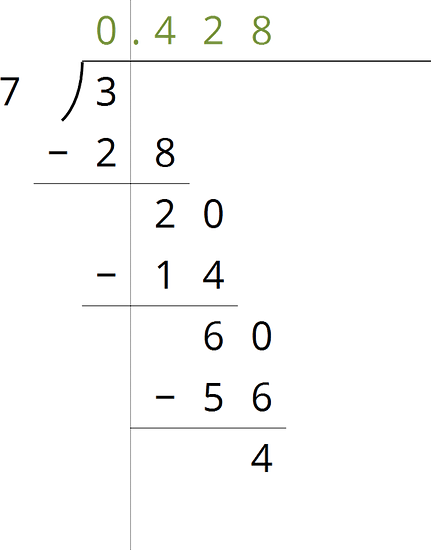Lección 15Expansiones decimales infinitas
Pensemos en decimales infinitos.
Metas de aprendizaje:
- Entiendo que todos los números tienen una expansión decimal.
- Puedo escribir un decimal que se repite como una fracción.
15.1 Busquemos dígitos
Se han calculado los primeros 3 dígitos después del punto decimal para la expansión decimal de . Halla los siguientes 4 dígitos.

15.2 Algunos números son racionales
El profesor le dará a tu grupo un juego de tarjetas. Cada tarjeta tendrá un lado con cálculos y un lado con una explicación.
-
Las tarjetas muestran el trabajo de Noah para calcular la representación de en forma de fracción. Organiza estas tarjetas en orden para ver cómo él descubrió que sin necesidad de una calculadora.
-
Usa el método de Noah para calcular la representación en forma de fracción de:
¿Estás listo para más?
Utiliza esta técnica para hallar representaciones en forma de fracción para y para .
15.3 Algunos números no son racionales
-
- ¿Por qué está entre 1 y 2 en la recta numérica?
- ¿Por qué está entre 1.4 y 1.5 en la recta numérica?
- ¿Cómo puedes determinar una aproximación para que tenga una precisión de hasta 3 cifras decimales?
-
Etiqueta todas las marcas. Ubica en las tres rectas numéricas. Asegúrate de agregar flechas desde la segunda hacia la tercera recta numérica.

-
- Elena observa que un vaso de laboratorio de la clase de ciencias dice que tiene un diámetro de 9 cm y ella mide su circunferencia que resulta ser 28.3 cm. ¿Qué valor obtienes para utilizando estos valores y la ecuación de circunferencia, ?
- Diego supo que uno de los tanques de combustible de un transbordador espacial tiene un diámetro de 840 cm y una circunferencia de 2,639 cm. ¿Qué valor obtienes para utilizando estos valores y la ecuación de circunferencia, ?
-
Etiqueta todas las marcas en las rectas numéricas. Utiliza una calculadora para obtener una aproximación muy precisa de y ubica ese número en las tres rectas numéricas.

- ¿Cómo puedes explicar las diferencias entre estos cálculos de ?
Resumen de la lección 15
No todos los números son racionales. Anteriormente tratamos de hallar una fracción que, al elevarla al cuadrado, fuera igual a 2. Eso resulta ser imposible, aunque podemos estar bastante cerca (trata de elevar al cuadrado). Como no hay una fracción que sea igual a , éste no es un número racional, por lo que lo llamamos un número irracional. Otro número irracional conocido es .
Cualquier número, racional o irracional, tiene una expansión decimal. A veces continúa indefinidamente. Por ejemplo, el número racional tiene la expansión decimal , en la que los 18 se repiten indefinidamente. Todos los números racionales tienen una expansión decimal que se termina en algún punto o termina en un patrón que se repite, como . Los números irracionales también tienen expansiones decimales infinitas, pero no terminan en un patrón que se repite. Desde el punto de vista decimal, podemos ver que los números racionales son bastante especiales. La mayoría de los números son irracionales, aunque los números que usamos a diario a menudo son racionales.
Problemas de práctica de la lección 15
Elena y Han discuten cómo escribir el decimal que se repite como una fracción. Han dice que es igual a . "Calculé porque el decimal se empieza a repetir después de 3 dígitos. Luego resté para obtener . Luego, multipliqué por para deshacerme del decimal: . Y finalmente dividí para obtener ". Elena dice que es igual a . "Calculé porque un dígito se repite. Luego, resté para obtener . Luego, hice lo mismo que Han para obtener y ".
¿Estás de acuerdo con alguno de ellos? Explica tu razonamiento.
¿En qué se parecen los números y ? ¿En qué se diferencian?
- Escribe cada fracción como un decimal.
-
-
Escribe cada decimal como una fracción.
-
- Escribe cada fracción como un decimal.
Escribe cada fracción como un decimal.
-
Write each decimal as a fraction.
-
y . Esto da cierta información sobre .
Sin calcular directamente la raíz cuadrada, ubica a sobre las tres rectas numéricas utilizando una aproximación sucesiva.
